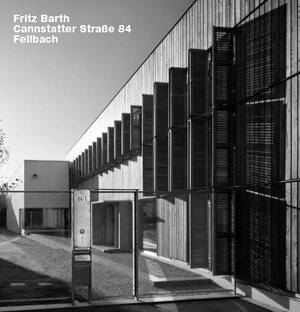
×
![Buchcover ISBN 9783932565762]()
Architekten, Bauhistoriker, Kunsthistoriker
Heroic 20th-century Modernism saw the private
home as a place to first test out utopian theories
– a place for free play and experimentation
where new approaches could be put into action,
on a small scale but no less radical. Here, where
architecture and life are closely interwoven, Frank
Lloyd Wright, Gerrit Rietveld, Le Corbusier and
Konstantin Melnikov found the suitable space to
give their visionary concepts a plastic reality.
The house built by Fritz Barth for his own use
in his home town of Fellbach places itself in an
ironic, possibly melancholic distance from this
kind of heroic pathos, but still has this tradition as
its background. So it is considered by his builder
as an experiment to determine the state of architecture
at the start of the 21st century – not to
apply whatever offers itself to expand the architectonic
repertoire, but to find out what possibilities
are still open to architecture and how far architecture
still permits a concept of 'dwelling' in
the sense the word was used by Heidegger.
The result is not a backward-looking homeliness,
but a structure that, as a commitment to architecture
in and of itself, stands his ground like
few others in its time and place. This is not least
because its complexity its multilayered, opulent
fabric of allusions, references and quotations, only
reveals itself gradually and with close observation
behind a simple appearance targeted on the immediacy
of experience and architecture. Despite
the somewhat polemical intentions of its builder
and inhabitant, the house is not experienced as
an ideological manifesto in bricks and mortar. It is
devoted to the immediate experience of 'dwelling'
in so far as it does not allow, as Thomas Hettche
writes in his essay, any distinction between surface
and function, life and experience.
Fritz Barth, born in 1958, studied architecture
in Stuttgart. He gained his PhD at the ETH Zürich
with a study of the Villa Lante (Die Villa Lante in
Bagnaia, Edition Axel Menges, 2001). He has also
written a monograph on the late-Baroque Bohemian
architect Johann Santini Aichel (Santini,
2004). Thomas Hettche, born in 1964, is a freelance
writer living in Frankfurt. His most recent
publication was the novel Die Liebe der Väter,
published in autumn 2010. Amber Sayah, born
in 1953 in Teheran, is one of the editors of the
arts pages of the Stuttgarter Zeitung and the author
of the book Architektur in Vorarlberg. Bauten
seit 2000. Until his retirement Gerhart Schröder,
born in 1934, was professor of Romance studies
at Stuttgart University. His publications include the
work Logos und List. Zur Entwicklung der Ästhetik
in der frühen Neuzeit.
home as a place to first test out utopian theories
– a place for free play and experimentation
where new approaches could be put into action,
on a small scale but no less radical. Here, where
architecture and life are closely interwoven, Frank
Lloyd Wright, Gerrit Rietveld, Le Corbusier and
Konstantin Melnikov found the suitable space to
give their visionary concepts a plastic reality.
The house built by Fritz Barth for his own use
in his home town of Fellbach places itself in an
ironic, possibly melancholic distance from this
kind of heroic pathos, but still has this tradition as
its background. So it is considered by his builder
as an experiment to determine the state of architecture
at the start of the 21st century – not to
apply whatever offers itself to expand the architectonic
repertoire, but to find out what possibilities
are still open to architecture and how far architecture
still permits a concept of 'dwelling' in
the sense the word was used by Heidegger.
The result is not a backward-looking homeliness,
but a structure that, as a commitment to architecture
in and of itself, stands his ground like
few others in its time and place. This is not least
because its complexity its multilayered, opulent
fabric of allusions, references and quotations, only
reveals itself gradually and with close observation
behind a simple appearance targeted on the immediacy
of experience and architecture. Despite
the somewhat polemical intentions of its builder
and inhabitant, the house is not experienced as
an ideological manifesto in bricks and mortar. It is
devoted to the immediate experience of 'dwelling'
in so far as it does not allow, as Thomas Hettche
writes in his essay, any distinction between surface
and function, life and experience.
Fritz Barth, born in 1958, studied architecture
in Stuttgart. He gained his PhD at the ETH Zürich
with a study of the Villa Lante (Die Villa Lante in
Bagnaia, Edition Axel Menges, 2001). He has also
written a monograph on the late-Baroque Bohemian
architect Johann Santini Aichel (Santini,
2004). Thomas Hettche, born in 1964, is a freelance
writer living in Frankfurt. His most recent
publication was the novel Die Liebe der Väter,
published in autumn 2010. Amber Sayah, born
in 1953 in Teheran, is one of the editors of the
arts pages of the Stuttgarter Zeitung and the author
of the book Architektur in Vorarlberg. Bauten
seit 2000. Until his retirement Gerhart Schröder,
born in 1934, was professor of Romance studies
at Stuttgart University. His publications include the
work Logos und List. Zur Entwicklung der Ästhetik
in der frühen Neuzeit.


